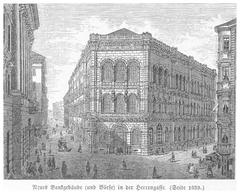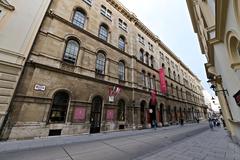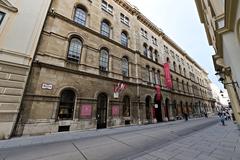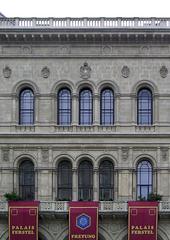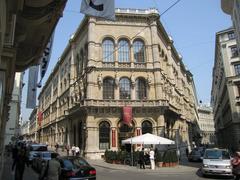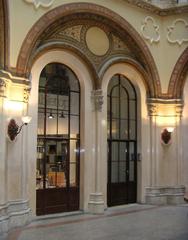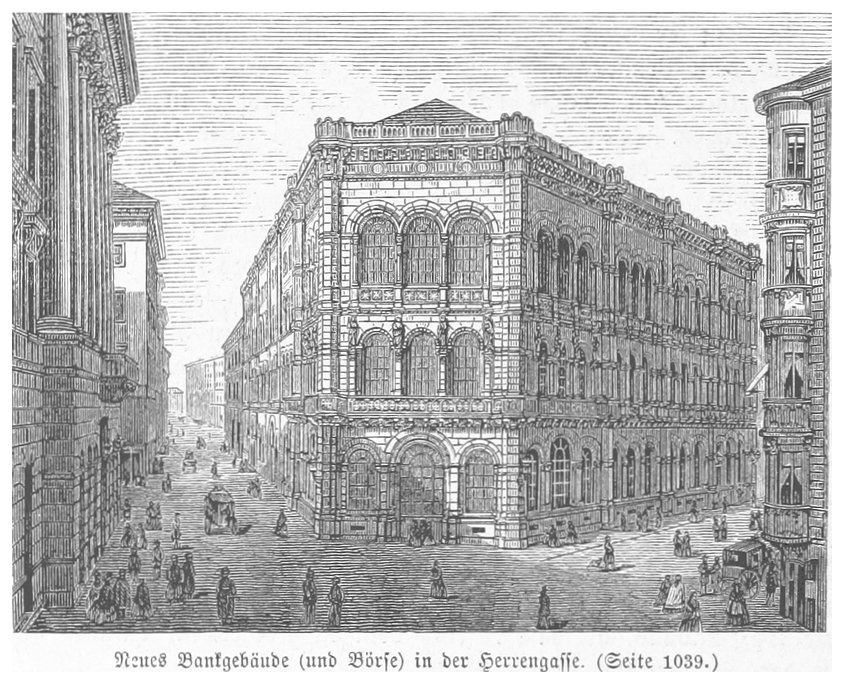
Palais Ferstel Vienna: Visiting Hours, Tickets, and Historical Sites Guide
Date: 14/06/2025
Introduction to Palais Ferstel Vienna and Its Significance
Located in Vienna’s historic Innere Stadt district, Palais Ferstel is a masterpiece of 19th-century architecture and a vibrant symbol of the city’s cultural heritage. Designed and constructed between 1856 and 1860 by Heinrich von Ferstel, this iconic building harmoniously blends Venetian-Gothic and Florentine-Renaissance styles. Characterized by its ornate marble arches, glass-roofed Ferstel Passage, and intricate detailing, the Palais reflects Ferstel’s Italian inspirations (palaisevents.at; en.wikipedia.org).
Initially built to house the Austrian National Bank and Vienna Stock Exchange, the palace quickly became a cultural and intellectual hub, most notably as home to the legendary Café Central since 1876—a gathering place for luminaries such as Sigmund Freud, Leon Trotsky, and Stefan Zweig (thetourguy.com; secretvienna.org). Today, Palais Ferstel is a cherished historic monument and a dynamic venue for art fairs, elegant events, and markets, making it a must-visit among Vienna’s historical sites (solosophie.com; theartfairguy.com).
Table of Contents
- Origins and Architectural Vision
- Original Purpose and Early Use
- Social and Cultural Significance
- Wartime Damage and Postwar Restoration
- Modern Era and Preservation
- Notable Architectural Features
- Visitor Information
- Timeline of Key Events
- Legacy of Heinrich von Ferstel
- Events and Contemporary Uses
- Frequently Asked Questions (FAQ)
- Travel Tips and Accessibility
- Nearby Attractions and Tours
- Visuals and Media
- Call to Action
- References and Further Reading
Origins and Architectural Vision
Palais Ferstel stands as a testament to Vienna’s 19th-century architectural innovation and cosmopolitan aspirations. Conceived between 1856 and 1860 by the young architect Heinrich von Ferstel, the building is one of the few Viennese palaces named after its architect (solosophie.com; palaisevents.at). Ferstel, inspired by his travels in Italy, infused the design with Venetian-Gothic and Florentine-Renaissance elements. The palace features ornate arches, a glass-roofed arcade, and a harmonious mix of marble and stucco (visitingvienna.com).
Original Purpose and Early Use
Commissioned as the headquarters for the Austrian National Bank and the Vienna Stock Exchange, Palais Ferstel opened in 1860 as one of Vienna’s most modern buildings (en.wikipedia.org; palaisevents.at). The ground floor initially housed the stock exchange, while the Ferstel Passage—modeled after Parisian shopping arcades—provided a luxurious covered thoroughfare that quickly became a permanent and beloved feature (solosophie.com; secretvienna.org).
Social and Cultural Significance
Palais Ferstel soon transcended its financial roots. In 1876, Café Central opened on the ground floor and became a legendary meeting place for Vienna’s intellectual elite, including Freud, Trotsky, and Zweig (palaisevents.at; thetourguy.com). The Ferstel Passage, with its hexagonal glass dome and the six-meter Donaunixenbrunnen (Danube Mermaid Fountain) by Anton von Fernkorn and Ferstel, was a fashionable destination for Viennese society (solosophie.com; fotoeins.com).
Wartime Damage and Postwar Restoration
World War II caused heavy damage to Palais Ferstel, especially its façade and interiors (en.wikipedia.org). Café Central closed in 1943, and the building fell into disrepair. Restoration began in 1971 under Walter Frodl, with the palace privatized in 1975 and major renovations completed by 1982. The restoration carefully preserved Ferstel’s original vision while adapting the palace for contemporary use (palaisevents.at).
Modern Era and Preservation
Since 2015, the Karl Wlaschek Foundation has owned Palais Ferstel, which now serves as a multifunctional venue for events, conferences, and celebrations (en.wikipedia.org; palaisevents.at). The Ferstel Passage remains open to the public, featuring boutiques, cafés, and a vibrant social scene. Café Central, reopened after a long hiatus, remains one of Vienna’s most iconic coffeehouses (thetourguy.com).
Notable Architectural Features
- Ferstel Passage: A marble-arched, glass-roofed arcade with boutiques and restaurants, crowned by a hexagonal dome (solosophie.com).
- Donaunixenbrunnen: A six-meter-tall Danube Mermaid Fountain by Anton von Fernkorn and Ferstel (fotoeins.com).
- Venetian and Florentine Influences: The façade and interiors feature pointed arches, colonnades, and Italian palazzo motifs (palaisevents.at).
- Café Central: Renowned for its vaulted ceilings, marble columns, and literary history (thetourguy.com).
Visitor Information
- Visiting Hours: Ferstel Passage: daily 10:00 AM–8:00 PM (closed Sundays). Café Central: 8:00 AM–11:00 PM daily. Hours may vary during holidays.
- Tickets: Entrance to the Ferstel Passage and Café Central is free. Special events and guided tours may require advance tickets, available online or on-site.
- Accessibility: Palais Ferstel is wheelchair accessible, with ramps and elevators. Assistance is available upon request.
- Guided Tours: Offered seasonally. Check the official website or local tourism portals for details and booking.
- Photography: Permitted in public spaces, including the Passage and Café Central; please respect other visitors.
- Nearby Attractions: Freyung Square, the Austrian National Library, and the Hofburg Palace are all close by.
Timeline of Key Events
- 1856–1860: Construction by Heinrich von Ferstel (palaisevents.at).
- 1860: Opening as the National Bank and temporary Stock Exchange.
- 1876: Café Central opens.
- 1943: Café Central closes; WWII damage.
- 1971–1982: Restoration and privatization.
- 2015: Karl Wlaschek Foundation assumes ownership (en.wikipedia.org).
Legacy of Heinrich von Ferstel
Heinrich von Ferstel (1828–1883) played a pivotal role in Vienna’s Gründerzeit era. His other masterpieces include the Votivkirche, the University of Vienna, and the Museum of Applied Arts (fotoeins.com). Ferstel’s innovative approach shaped Vienna’s cityscape and architectural identity.
Events and Contemporary Uses
Prestigious Art Fairs and Cultural Events
Palais Ferstel is a leading venue for Vienna’s cultural events, notably the WIKAM art fair (Wiener Internationale Kunst- und Antiquitätenmesse), which showcases fine art, antiques, and design (theartfairguy.com). The fair is a key fixture in Vienna’s art calendar, drawing collectors and art lovers to the palace’s grand halls each spring.
Private Functions and Gala Celebrations
The palace is also a sought-after location for elegant private events, including weddings, corporate galas, and receptions. Its historic halls offer period décor and modern amenities (ep11-dach-abend.wien).
The Ferstel Passage: Shopping, Leisure, and Social Life
The Ferstel Passage, inspired by Parisian arcades, houses boutiques, specialty shops, and gourmet outlets. Its glass-roofed walkway and mosaic floors provide a unique shopping and leisure experience (secretvienna.org).
Café Central: A Living Viennese Institution
Café Central, attached to the Palais, remains a vibrant center for Viennese coffeehouse culture, regularly hosting readings, musical performances, and themed events (secretvienna.org).
Guided Tours and Exclusive Experiences
Guided tours of Palais Ferstel, including its hidden architectural gems, are available and can be tailored to interests such as architecture, art history, or culinary traditions (secretvienna.org).
The Contemporary Art Scene
Beyond WIKAM, Palais Ferstel is part of Vienna’s expanding art fair landscape, hosting and supporting a variety of cultural and artistic events throughout the year (theartfairguy.com).
Seasonal and Thematic Events
The palace and passage host seasonal markets, artisan fairs, and festive celebrations, especially during the Christmas season, attracting both locals and tourists.
Frequently Asked Questions (FAQ)
What are Palais Ferstel’s visiting hours?
Ferstel Passage: daily 10:00 AM–8:00 PM (closed Sundays). Café Central: 8:00 AM–11:00 PM. Hours for special events may vary.
Is there an entrance fee?
Access to public areas and Café Central is free. Tickets are required for special exhibitions, art fairs, or guided tours.
Are guided tours available?
Yes, guided tours are offered seasonally and can be booked online or at the venue.
Is Palais Ferstel wheelchair accessible?
Yes, with ramps, elevators, and assistance upon request.
Can I take photographs inside?
Yes, photography is permitted in public areas, including the Passage and Café Central.
How do I get there?
Located near Freyung Square, Palais Ferstel is accessible via U-Bahn lines U1, U3, and U4.
Travel Tips and Accessibility
- Getting There: Easily reached by public transport. Closest U-Bahn stations: Herrengasse (U3) and Schottentor (U2).
- Accessibility: Wheelchair access with ramps and elevators; assistance available.
- Photography: The arcades and courtyards are ideal for photos.
Nearby Attractions and Tours
Palais Ferstel’s central location makes it a great starting point for exploring Vienna’s historic core. Notable nearby sites include Schottenstift Abbey, Freyung Square, St. Stephen’s Cathedral, the Vienna State Opera, and the Austrian National Library.
Visuals and Media
Enjoy high-quality images of Palais Ferstel’s façade, the ornate Ferstel Passage, and the atmospheric Café Central. Virtual tours and interactive maps are available on the official website for trip planning.
Call to Action
Plan your visit to Palais Ferstel and immerse yourself in Vienna’s architectural splendor, intellectual legacy, and coffeehouse tradition. Stay up to date on events, ticketing, and exclusive experiences by visiting the official Palais Ferstel website, downloading the Audiala app, or following us on social media.
References and Further Reading
- Palais Ferstel
- Palais Ferstel - TourMyCountry
- Palais Ferstel - Live the World
- The Art Fair Guy - Vienna’s Art Fair Scene
- Wikipedia: Palais Ferstel
- Ferstel Passage - Solo Sophie
- Secret Vienna - Ferstel Passage
- Café Central - The Tour Guy
- GPSmyCity: Palais Ferstel
- FlyPharma Europe Gala Dinner
- EP11 Dach Abend: Das Palais Ferstel
- Fotoeins: Heinrich von Ferstel
